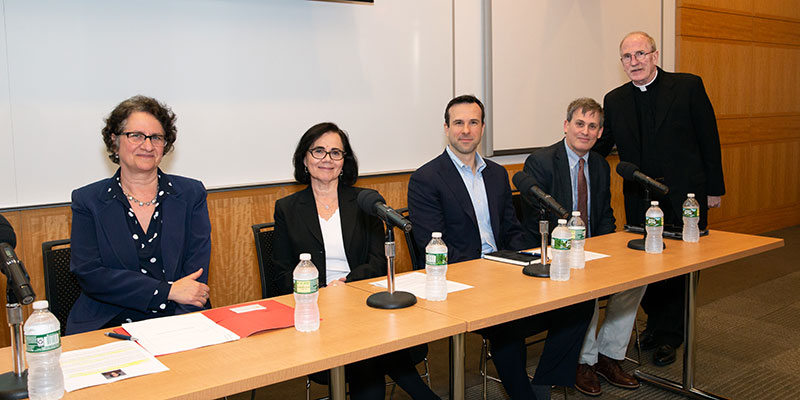The answer lies in innovation, according to a group of industry experts who spoke at a May 7 event at Fordham’s Lincoln Center campus titled “Transforming Employer-Provided Health Plans: Innovating for Patient-Centered Value.”
Falguni Sen, director of Fordham’s Global Healthcare Innovation Management Center, which hosted the event, framed the extraordinary scale of the challenge in his introductory remarks.
“We are going to try to the impossible,” he said. “Making health care better than it is by changing the nature of both affordability and access.”
Rapidly rising health care costs have impacted health benefits in a number of ways that often leave both employers and employees dissatisfied, Sen said. This often results in narrower provider networks, more frequent billing, and recurrent claims disputes, among other issues.
“Employers want their employees to be healthy and their costs to be lower,” Sen said. “Employees want their employers to be successful, but not at the cost of lowering their health care benefits.”
Sen and an expert panel of health care industry leaders explored innovative ideas that will help achieve these twin goals during a wide-ranging discussion that drew heavily on the panelists’ real world application of novel and effective techniques.
Mitra Behroozi, executive director of Benefit and Pension Funds for 1199SEIU, the largest health care workers union in the U.S., illustrated how health care plans can harness “the power of zero” to deliver exceptional service at an exceptional value.
The nearly 400,000 members covered by the union’s benefit funds pay nothing toward their premiums and are responsible for no co-pays, coinsurance, or deductibles when following plan rules. But despite the extremely rich benefits enjoyed by members, the funds’ costs are well below both regional and national averages on a per worker basis.
Behroozi, who co-moderated the panel with Sen, explained that while some employers have directed rising costs to workers in the form of deductible and premium increases, the 1199SEIU Benefit Funds have taken an alternate approach.
“When you engage in extreme cost shifting, patients avoid needed care as well as unneeded care,” she said, continuing, “Our cost-containing principles are to maintain the availability of quality care and avoid financial barriers for our members.”
1199SEIU’s example demonstrates that quality benefits don’t necessarily have to come with high premiums and out-of-pocket expenses, she said, if plans are designed to incentivize choices that reduce overall costs.
“Our opportunity when we design benefits is to make it simple for people to use the highest-value things and to avoid the lowest-value things,” Behroozi said.
Claire Levitt, the deputy commissioner of the New York City Mayor’s Office of Labor Relations, shared her public sector perspective on how the city achieved $3.4 billion in health care cost savings that were used to fund wage increases for municipal employees.
One crucial step taken by the city, Levitt explained, was to begin collecting data on patient care costs, which had never been gathered before due to privacy concerns. Guided by this information, the city began adjusting beneficiaries’ out-of-pocket expenses to encourage preventive care and reduce the number of cost-driving visits to urgent care and emergency rooms.
Michael Chernew, the Leonard D. Schaeffer Professor of Health Care Policy at Harvard Medical School, drew on his experience both as a health economist and as chair of the university’s benefits committee. He noted that employers must consider not only insurance carriers’ costs, but also how the services available through their plans will accommodate employees’ needs. “You want to look for a carrier that can manage the care and has relationships with the delivery system,” Chernew said.
Tom Traylor, general manager of pharma solutions at the Health Transformation Alliance, explained how his company identifies high-value providers and treatments through data and analytics. The Health Transformation Alliance is owned by 50 blue-chip companies, each of which share health care data that can be leveraged to compare outcomes and produce better results for all of the 4.5 million individuals covered under the employers’ plans.
He detailed how thoughtfully constructed prescription drug formularies can drive patients toward high-efficacy drugs and exclude low-value, high-cost drugs.
“Just because the FDA approved it does not necessarily mean that it provides any additional value,” Traylor said. “You can have a drug that is one to two percent better or worse but 20 percent more expensive, and it’s in a category where there are drugs already available. Why have that drug available?”
While it is difficult to predict possible policy changes and technological developments that will help shape the future of American health care, Sen said, the innovations discussed by the panel will have a major role to play.
“In the next few years we are going to really see major changes in the way health care is delivered and paid for,” he said.
Sen quoted a remark his co-moderator Behroozi made to him about the task putting into motion the changes that will drive this transformation: “The main innovation lies in making innovation happen.”
— Michael Garofalo




